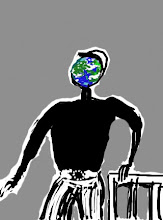Wittgenstein supposedly, and doubtless apocryphally, once discussed the matter of the geocentric model of the solar system. Of course, said Russell (or the student, or whoever his interlocutor was), you can't blame the medievals. The geocentric model of the solar system makes a kind of sense. After all, it does look, from an Earthly perspective, as if the sun revolves around us.
To which Wittgenstein supposedly replied: Really? And how would it look if it were the other way round?
It's a riposte designed to bully-down dialogue with its brilliance (naturally, it would look exactly as it actually does, since the Earth does indeed revolve around the sun!). But that's not the proper answer. The proper answer would be something like this.
It would look as though the sun were more massy, not the bubble of hot light we see. It would look as though the earth were less fixed. It would look as though the sky were a transparent medium, instead of the blue dome we actually see capping our human-sized world. If we moved about the sun, then we might expect to see the sun from all angles--which is to say, we might expect to be able to notice the differences between the brightnesses of the sun from front and back. We might expect to see, winter and summer, a difference in the distances of the various stars (surely, only some few billions of kilometers away from us!) in relation to one another, if our orbit truly took us on such a lengthy detour.
After all, how commonsensical is it that the earth's rotation about its own axis and the earth's rotation about the sun need to be plaited together to give an answer to the problem of day and night?
It seems to me that there's an insufficienct of relativism in Wittgenstein's bon mot.
More, there is something altogether too cosy, too flip-up, flip-about, in the way we have relocated our mental maps to the heliocentric model. In effect doing so preserves all the old human biases, with this one topsyturvying gesture of replacing one massy body (us) with another (helios). What would it look like if the sun went about the Galactic core? Why don't we talk about a galactocentric model of the solar system?
Monday 30 April 2007
Subscribe to:
Post Comments (Atom)

No comments:
Post a Comment